ການເອົານິວເຄລຍເຊື່ອມເຂົ້າກັນ ເຮັດໃຫ້ພວກນັກວິທະຍາສາດທັງ ຫລາຍມີຄວາມຕື່ນເຕັ້ນມາໄດ້ຫລາຍທົດສະວັດແລ້ວ ໂດຍທີ່ມີທ່າແຮງທີ່ຈະຜະລິດພະລັງງານທີ່ບໍ່ມີທາດຄາບອນຢ່າງຫລວງຫຼາຍອອກມາ. ໃນນະຄອນ
ຊີແອດໂທລ, ລັດວໍຊິງຕັນນັ້ນ, ບໍລິສັດເລີ່ມຕົ້ນແຫ່ງນຶ່ງ ຫວັງວ່າ ຈະຊະນະການແຂ່ງຂັນໃນການພັດທະນາເທັກ ໂນໂລຈີທີ່ວ່າ ໃນທີ່ສຸດກໍຈະເຮັດໃຫ້ພະ ລັງງານອັນນັ້ນ ມີໄວ້ໃຫ້ຜູ້ຊົມໃຊ້. Phil Dierking ມີລາຍງານຂອງພວກເຮົາ ຊຶ່ງບົວສະຫວັນ ຈະນໍາມາສະເໜີ ທ່ານໃນອັນດັບຕໍ່ໄປ.
ພະລັງງານນິວເຄລຍໃນທຸກມື້ນີ້ ແມ່ນມາຈາກການແຍກນິວເຄລຍທີ່ມີສອງອາຕອມ ຫລື fission, ເຊິ່ງເກັບກໍາເອົາພະລັງງານຂອງອາຕອມ ທີ່ແຍກອອກ ຈາກກັນນັ້ນ. ແຕ່ການແຍກອອກຈາກກັນ ກໍເຮັດໃຫ້ເກີດຜະລິດຕະພັນກຳມັນຕະພາບລັງສີທີ່ສາມາດເປັນອັນຕະລາຍໄດ້ເຊັ່ນກັນ. ການລວມເອົາອາຕອມ ເຫຼົ່ານັ້ນເຂົ້າໄປໃນອາຍແກສຮີລຽມ (helium), ດັ່ງທີ່ເກີດຂຶ້ນຢູ່ໃນດວງຕາເວັນ ບໍ່ໄດ້ຜະລິດ ຜະລິດຕະພັນທີ່ເປັນອັນຕະລາຍອອກມາ ແລະສາມາດຜະລິດພະລັງງານສະອາດຢ່າງອຸດົມສົມບູນໄດ້. ທ່ານເບນ ເລວິດ (Ben Leavitt) ເປັນຜູ້ຊີ້ ນຳການຄົ້ນຄວ້າ ແລະການພັດທະນາຢູ່ບໍລິສັດພະລັງງານແຊບ ຫລື Zap Energy ຂອງສະຫະລັດ.
ທ່ານກ່າວດັ່ງນີ້:
“ການເຊື່ອມເຂົ້າກັນແມ່ນບາດກ້າວຕໍ່ໄປໃນການພັດທະນາຂອງມະນຸດ. ພະລັງ ງານເຊື້ອໄຟມີຢ່າງອຸດົມສົມບູນ, ແລະປອດໄພ ແລະບໍ່ມີທາດຄາບອນ, ແລະສາມາດເຮັດໃຫ້ພວກເຮົາພົ້ນຈາກການຈໍາກັດຂອງແຫຼ່ງພະລັງງານຢູ່ໃນພື້ນດິນໄດ້."
ພະລັງງານຈາກການເຊື່ອມເຂົ້າກັນ ແມ່ນບໍ່ສາມາດໃຊ້ທາງການຄ້າໄດ້ຢ່າງຈະ ເລີນເຕີບໂຕໃນທຸກມື້ນີ້ ເນື່ອງຈາກວ່າ ການທີ່ຈະເຊື່ອມອາຕອມເຂົ້າກັນ ມັນຍາກກວ່າ ການແຍກພວກມັນອອກຈາກກັນ. ສ່ວນນຶ່ງ ກໍແມ່ນເປັນຍ້ອນ ພະລັງງານ ແລະ ຄວາມຮ້ອນທີ່ຮຸນແຮງທີ່ຕ້ອງການເພື່ອຈະໃຫ້ເກີດປະຕິກິລິຍາທາງເຄມີນັ້ນ ອອກມາໃນສະພາບແວດລ້ອມທີ່ຖືກຄວບຄຸມຢູ່. ທ່ານ ເລວິດ ອະທິບາຍວ່າວິທີການຂອງບໍລິສັດ Zap Energy ແມ່ນອີງໃສ່ແນວຄວາມຄິດການເຊື່ອມເຂົ້າກັນອັນທໍາອິດທີ່ໄດ້ຖືກສຶກສາຄົ້ນຄວ້າໃນຕົ້ນຊຸມປີ 1950.
ທ່ານກ່າວດັ່ງນີ້:
"ມັນໃຊ້ໃຍແສງຂອງມັນເອງ ສໍາລັບການກັກຂັງມັນເອງ ແລະຄວາມຮ້ອນຂອງ ມັນເອງ. ແລະໂດຍການປ່ອຍກະແສໄຟຟ້າທີ່ສູງແທ້ໆຜ່ານວັດຖຸໃຍແສງທີ່ເປັນ ເສັ້ນຊື່, ທ່ານສາມາດຄິດເຫັນມັນວ່າຄ້າຍຄືກັບສາຍຟ້າຜ່າ, ມັນສ້າງສະຫນາມແມ່ ເຫຼັກຂອງມັນເອງ, ແລະສະຫນາມແມ່ເຫຼັກຂອງມັນເຮັດໃຫ້ມັນກັກຂັງໂຕເອງ ແລະເຮັດໃຫ້ມັນຮ້ອນຂຶ້ນເຖິງຂັ້ນເກີດສະພາບທີ່ເຊື່ອມເຂົ້າກັນໄດ້.”
ຫຼັງຈາກການຄົ້ນຄວ້າມາໄດ້ຫຼາຍທົດສະວັດ, ຜູ້ອໍານວຍການໂຄງການຄົ້ນຄ້ວາ ຂັ້ນສູງຂອງກະຊວງພະລັງງານຂອງສະຫະລັດ, ທ່ານອາເມດ ເດຍໂລ (Ahmed Diallo) ກ່າວວ່າ "ສິ່ງທ້າທາຍອັນໃຫຍ່ຫຼວງ" ຂອງພະລັງງານ ຈາກນິວເຄລຍ ເຊື່ອມເຂົ້າກັນອາດຈະສາມາດແກ້ໄຂໄດ້.
ທ່ານເດຍໂລ, ຈາກກະຊວງພະລັງງານສະຫະລັດກ່າວຜ່ານ Zoom ວ່າ:
"ແລະຂ້າພະເຈົ້າຢາກໃຫ້ຄົນເບິ່ງ ຖ້າເຂົາເຈົ້າສາມາດວາດພາບເບິ່ງຕົນເອງ ວ່າ ໃນມື້ທີ່ພວກເຮົາມີພະລັງງານຈາກນິວເຄລຍເຊື່ອມເຂົ້າກັນ ພວກເຮົາຈະບໍ່ກັງວົນ ໃຈກ່ຽວກັບພະລັງງານອີກ. ນັ້ນແມ່ນວິທີທີ່ຂ້າພະເຈົ້າຢາກໃຫ້ຄົນຮັບຮູ້ມັນ. ທ່ານມີພະລັງງານອັນອຸດົມສົມບູນ, ທ່ານບໍ່ໄດ້ຖືກຈໍາກັດໃຫ້ມີພຽງແຕ່ມາຈາກໂຮງໄຟຟ້າສອງສາມແຫ່ງ, ແລະຈາກນັ້ນ ພວກເຮົາກໍສາມາດສືບຕໍ່ ແລະພະຍາຍາມແກ້ໄຂບັນຫາອື່ນໆໄດ້.”
ບໍລິສັດ Zap Energy ແມ່ນນຶ່ງໃນ 8 ບໍລິສັດ ທີ່ໄດ້ຮັບທຶນຈາກ ກະຊວງພະລັງ ງານເພື່ອສ້າງໂຮງໄຟຟ້າທົດລອງ ເພື່ອທົດລອງເທັກໂນໂລຈີເຊື່ອມເຂົ້າກັນນີ້.
ອ່ານຂ່າວນີ້ເປັນພາສາອັງກິດຂ້າງລຸ່ມນີ້:
Nuclear fusion has excited scientists for decades with its potential to produce abundant carbon-free energy. In Seattle, one startup is hoping to win the race to develop technology that will finally make that power available to consumers. Phil Dierking has our story.
Nuclear power today comes from fission, which captures the energy of splitting atoms. But that splitting also causes radioactive byproducts that can be harmful. Fusing those atoms into helium, as happens inside the sun, does not produce harmful byproducts and could produce abundant clean energy. Ben Leavitt directs research and development at the U.S. firm Zap Energy.
Ben Levitt, Zap Energy:
“Fusion really is the next step in humanity’s development. The fuel is abundant, and safe and carbon free, and can set us free from the confines of, you know, terrestrial sources of energy.”
Fusion power is not commercially viable today because it is harder to fuse atoms than it is to split them. In part, that is because of the extreme energy and heat required to produce that reaction in a controlled environment. Levitt explains Zap Energy’s approach based on one of the first fusion concepts studied in the early 1950s.
Ben Levitt, Zap Energy:
“It uses the plasma itself for its own confinement and its own heating. And by passing a really high current through a linear plasma object, you can think of it as like a lightning bolt, it creates its own magnetic field, and its own magnetic field gives it its own confinement and heats it to fusion conditions.”
After decades of research, U.S. Department of Energy advanced research projects director Ahmed Diallo says the “grand challenge” of fusion power may be within reach.
Ahmed Diallo, US Department of Energy:
“And I want people to see, if they can project themselves, that the day we have fusion energy, we won’t have to worry about energy. That’s how I would like people to realize it. You have abundant energy, you’re not really limited to only a few power plants, and then we can move on and try to solve other problems.”
Zap Energy is one of eight recipients of Department of Energy funding to build a pilot power plant to test this fusion technology.





